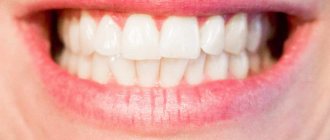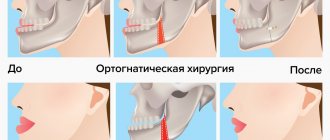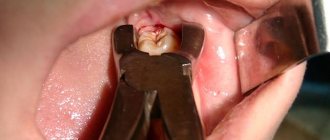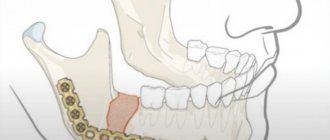The most common operation in dentistry is the removal of lower or upper teeth. Thanks to modern anesthetics and the latest medical equipment, patients at the dental clinic can undergo it without pain and with minimal risk of complications. Doctors do everything possible to ensure that the postoperative period is easy and does not cause significant discomfort in the patient.
Indications for removal of lower teeth
Conventionally, all indications for surgical intervention in the lower jaw can be divided into groups:
- Chronic intoxication resulting from advanced dental disease. It can lead to sepsis, myocarditis, endocarditis and other dangerous connective tissue lesions.
- Purulent processes in the periodontium, if they cannot be stopped using conservative methods.
- Acute osteomyelitis, perimaxillary abscess, phlegmon, sinusitis caused by a destroyed tooth. Extraction is carried out only if the disease cannot be eliminated by therapeutic methods.
- Longitudinal fracture, splitting of the crown into 2-3 parts with exposure of deep layers of the pulp (if it is impossible to close the defect with filling material).
- The presence of units that are positioned incorrectly and injure the surrounding mucous membranes, but are not subject to orthodontic treatment.
- Detection of elements that have not fully erupted, causing inflammatory reactions in adjacent areas.
- To eliminate malocclusions before starting an orthodontic course.
- The presence of supernumerary lower units that interfere with proper oral hygiene, prosthetics, disrupt chewing function, or cause constant pain.
When is surgery indicated?
Indications can be called urgent and planned. The difference between them is that with an urgent operation, the clinical picture in the oral cavity and the general condition of the patient does not require delay. Delay may result in complications not only in the maxillofacial area, but the patient’s general condition may worsen.
Urgent indications include:
- A situation where dental tissues are severely destroyed and do not provide any functional benefit, but only aggravate purulent inflammatory processes in the oral cavity and soft tissues of the face. Usually these processes come from this jaw structure, due to the constant accumulation of pathogenic microflora there. Untimely treatment can cause the following purulent-inflammatory processes: periodontitis, periostitis, sinusitis, phlegmon or abscess.
- Diagnosed osteomyelitis in the projection of a destroyed, diseased dental unit.
- Longitudinal dental fracture.
- Transverse fracture of the dental crown with opening of the pulp chamber, but due to curvature or resorption of the roots, the tooth cannot be treated endodontically.
When should a lower tooth not be removed?
If we talk about contraindications to surgical intervention, then it will have to be postponed if:
- Cardiovascular pathologies. It is necessary that at least three to six months have passed after a hypertensive crisis, heart attack, coronary disease and other severe cardiac pathologies.
- Acute diseases of the kidneys, liver, pancreas.
- ARVI and ARI. This refers to flu, colds, pneumonia, etc.
- Disturbances in the functioning of the cardiovascular system, for example, with meningitis, encephalitis, problems with cerebral circulation.
- Exacerbations of mental illness.
- Untreated diseases of the oral cavity - stomatitis, gingivitis, gumboil, etc.
As soon as the underlying disease is cured, extirpation can be performed immediately, but not before. Otherwise, the recovery process will be delayed and complicated.
Contraindications
There are contraindications to removal, these include:
- aggravated form of cardiovascular diseases;
- any infectious exacerbation;
- pathologies and poor blood clotting;
- strokes;
- mental illness;
- heat;
- stomatitis.
The doctor is also obliged to examine the patient and rule out a negative reaction to painkillers. After this operation, it is necessary to monitor the patient’s condition and exclude bleeding, severe pain and inflammation. Tooth extraction with a professional approach does not pose a threat to health or life and is part of the normal practice of a dentist.
The New Technologies Clinic provides modern technologies. Call us now!
Methods
There are two ways to pull out a lower tooth:
- Simple. It is relevant if the coronal part has been preserved in sufficient volume (the dentist has something to grasp with forceps).
- Surgical. It is used if access to the tooth is difficult or its upper part is severely damaged, as well as when molars, canines and incisors have not fully erupted. In such cases, in order to minimize the risk of developing severe postoperative inflammation, professional hygiene is first carried out and plaque accumulations are removed, and the patient is prescribed antibiotics a few days before the procedure.
Before extirpation, local anesthesia is administered. It makes the working area insensitive to manipulation and helps the patient easily endure all procedures.
The value of x-ray diagnostics when removing wisdom teeth
No qualified doctor will remove wisdom teeth “blindly”. You cannot rely on external indicators. A clear assessment of the condition of the root system and the development of the tooth is necessary in order to eliminate complications that could arise after the operation. An x-ray must be taken to assess the feasibility of removing a particular wisdom tooth.
X-ray examination provides an informative picture that allows you to see:
- the presence of curved roots;
- number of root shoots;
- structural features.
Based on the results of X-ray diagnostics, the doctor will be able to draw up a surgical plan and eliminate errors in the form of bone fragments remaining in the gum.
Oral care after lower tooth extraction
Upon completion of the dental intervention, the doctor gives the patient recommendations on how to behave so that the recovery is successful and in the shortest possible time. Necessary:
- Do not eat anything for the first two to three hours after treatment. It is important that a clot forms in the hole, which will protect it from the penetration of bacteria.
- Do not touch the wound with your tongue or foreign objects.
- Do not use paste or brush on the day of the procedure.
- Rinse your mouth only if prescribed by your doctor.
- Visit the doctor on the appointed day for a follow-up examination.
It is important to understand that dental operations today are only vaguely reminiscent of those performed a couple of decades ago. They are as gentle as possible and are not associated with pain and long-term rehabilitation.
Easy removal
Simple extraction is the extraction of a tooth without the use of additional tools or techniques. A simple operation is observed after complete eruption, correct positioning of the molar, and the absence of serious pathologies. The doctor applies forceps and, after rocking movements, removes the molar from the jaw
The following stages of the procedure can be distinguished:
- Anesthesia;
- Selection and preparation of tools;
- Tooth ligament separation;
- Application and fixation of forceps;
- Luxation of a molar;
- Extraction from bone;
- Checking the hole;
- Stop bleeding;
- Recommendations for the patient.
Complications
When lower teeth are removed, the tissues that surround them are injured. This cannot be avoided, since the jaw apparatus very securely holds the roots in the hole.
Therefore, after the intervention, the patient sometimes experiences:
- Edema. Caused by partial destruction of tissues that are located near the wound. As a rule, it goes away on its own in a few days.
- Swelling of the gums, gumboil. Painful symptoms can be relieved by applying cold compresses.
- Increased body temperature. It is considered a normal reaction to inflammation. Lasts up to three days. You need to take anti-inflammatory and antipyretic medications prescribed by your dentist.
- Pain. Usually the gums and cheek hurt. Also, discomfort can spread to the throat, lower and upper jaw. They are explained by damage to the periodontal nerves and tissues and gradually go away on their own.
- Local bleeding. Most often, blood flows only immediately after removal, but sometimes it begins to re-release several hours after the intervention. Then you need to apply a sterile gauze swab to the hole and gently bite it.
- Discharge of pus. Speaks of infection and requires urgent medical consultation. Most often, this complication is encountered by people who ignored the doctor’s orders and were inattentive to the condition of their oral cavity during the recovery period.
- Paresthesia or numbness of part of the face or tongue. It is a consequence of difficult removal. It is more common if a wisdom tooth has been pulled out. Usually the symptom goes away within two weeks.
- Dry hole. Normally, a small blood clot forms immediately after surgery. If it is not there, the place is left uncovered, they call it a dry socket. It is considered a complication because the wound remains open to infection. At the same time, a person may experience ear or throat pain, alveolitis, and inflammation of the gums. To avoid these problems, you need to see a doctor. He will put a special wound-healing gel into the cavity.
Dentists carry out treatment following established norms and rules, using disposable sterile instruments and prescribing an effective treatment regimen for each client, which makes the postoperative recovery process quick and painless.
Bleeding
If bloody discharge appears from the socket of an extracted wisdom tooth, you should call your doctor and report the situation. Minor gum bleeding can occur due to tissue injury, high blood pressure, or problems with blood clotting. In most cases, this does not threaten health and goes away on its own. If bleeding is severe or frequently repeated, you should inform your doctor and come for an examination. To prevent complications, you should rest more for several days, avoid physical activity, and monitor your blood pressure.
Pain in the socket
Everyone experiences pain after removal surgery and worries for several days. The intensity of pain will depend on the traumatic nature of the operation and the complexity of the surgical interventions. During the postoperative period, the dentist recommends using painkillers. If the pain does not disappear, but intensifies after 3-4 days, this may indicate complications. A professional examination and consultation with a doctor are required.
Causes of impacted teeth
- Due to injury or damage to the jaw;
- If the child’s primary fangs were pulled out prematurely;
- Incorrect location of the tooth germ;
- Dental crowding, which means teeth are too close together;
- Inflammatory diseases of baby teeth and gums;
- The presence of “extra” teeth (supercomplete);
- Poor nutrition;
- Rickets;
- Exhaustion or weakness of the body.
The main prerequisite for the appearance of retention is the peculiarities of the child’s development in the embryonic period (lack of minerals in the body, thickening of the mucous membranes, low fetal growth rate).
Extraction methods
The standard method of removal for third molars is rarely used, only on the condition that eruption has proceeded normally, and the figure eight itself is in the correct position and has a normal root structure. Dentists at the Dentospas clinic recommend performing a more gentle and safe atraumatic removal of:
- after dissection of the gums or detachment of soft tissues, the tooth is divided into segments using a special tool;
- each of the segments along with the root is removed from the hole;
- the hole is processed, if necessary, stitches are applied.
Advantages:
- atraumatic removal is gentle on bone tissue. A small part of it can be removed if the molar is dystopic or impacted. Moreover, all manipulations are controlled, the doctor precisely regulates the volume of intervention, injury is minimal;
- if there are several roots, they have a non-standard location, are directed in different directions, and interfere with neighboring teeth, the atraumatic removal technique allows you to work separately with each of them. The root is removed safely, without damaging nearby tissues, regardless of its size, direction of growth, etc.;
- recovery after atraumatic removal is faster. It takes up to several days. The risk of complications is minimal.
At the Dentospas clinic, when removing wisdom teeth, precise diagnostics are used (to assess the position, number and condition of the roots, etc.). We perform third molar extraction using several methods. After the procedure, APRF technology can be used for faster healing.
Types of location of an impacted tooth
| Fine | The tooth has a vertical position and grows upward very slowly. Baby teeth and canines can grow properly. “Wisdom teeth” are rarely positioned normally. |
| Horizontally | The impacted tooth forms a right angle to the healthy one, located horizontally. This situation is detrimental to a healthy “neighbor”. In such a situation, it is necessary to remove the impacted tooth, which is performed only surgically. |
| Obliquely | An impacted tooth grows at an angle toward the cheek or tongue. If such an anomaly does not cause inconvenience to a person, then removal is not necessary. |
Symptoms of tooth impaction
In most cases, an impacted tooth is detected on an x-ray at the dentist or at an appointment with an ENT doctor. Retention in a child can be determined if one of the elements of the jaw row is absent for a long time or if a baby tooth is not replaced by a permanent “brother” for too long. The eruption of an impacted tooth is usually accompanied by inflammatory processes. The child may be bothered by swelling of the gum tissue and jaw, pain and aches, numbness and tingling in the retention zone.
On palpation of the gums, thickening and hardening are noted, reminiscent in shape and outline of an unerupted tooth.











